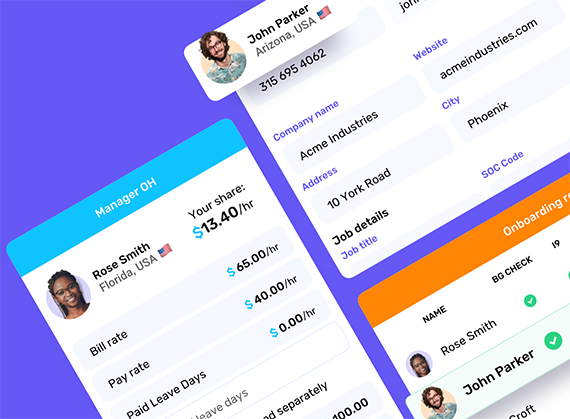Negotiating contractor pay rates can be one of the most daunting parts of placing a contract candidate when you are first getting started. It’s also one of the most important. The contractor pay rate is vital for determining how to calculate the bill rate charged to the client. But, where do you start?
The starting point for negotiating contractor pay rates
When negotiating a contract candidate’s pay rate, it may feel like you are between a rock and a hard place. After all, both the client and the candidate are your customers. You have to make your client happy if you hope to get future job orders. And, a satisfied candidate will likely turn to you for future contract staffing opportunities and may even refer friends looking for contract work.
Fortunately, negotiating contractor pay rate is not as difficult as it may seem. If you have experience placing direct hires for the position in question, there is a common rule of thumb for negotiating a contract rate.
Usually, you can take the typical annual salary for a direct hire and divide it by 2,080. Why 2,080? That’s the average number of working hours per year.
There are a couple of tools on the Internet that can give you a starting place for contract salary negotiation:
- Bureau of Labor Statistics (BLS) Occupational Employment Statistics – This site provides national hourly and salary wage estimates for about 800 occupations based on semi-annual mail surveys. It also allows you to narrow down the data by industry or geographic location.
- www.salary.com – The site’s free “Salary Wizard” allows you to search its database by job title and location, providing a range of salaries as well as the median salary for the criteria selected.
How to negotiate contract salary: things to consider
What should you do when a client doesn’t set any limit on the hourly bill rate for a contract placement? While it might sound like a great problem to have, this can be frustrating because you have no clue what rate the client considers acceptable—you have to guess.
If you keep your hourly fee (a.k.a. “recruiter share”) low and ask a lower bill rate than the client expects, they’ll be pleased. But, you might be shorting yourself. On the other hand, select a rate too steep and you could wind up losing the contract placement and injuring your reputation.
There is no one correct way to set the bill rate. The important thing is to be creative with each client and come up with a rate structure that will keep both of you happy. Here are three factors to consider when negotiating contractor pay rates.
Consider unique candidate features
Just as every candidate has a unique skill set and experience level, the contractor rates you negotiate can differ from client to client. Consider what the candidate you’re placing has to offer before coming up with a final pay rate. Adjust the hourly pay rate based on the unique details of the contract placement.
Some factors tend to raise the pay rate:
- Short-term contracts sometimes require higher pay rates because it’s hard to find candidates to take those positions.
- The candidate has skills that are particularly valuable or rare.
- The position requires travel or relocation.
On the other hand, some factors can lower the pay rate:
- The candidate has been unemployed, particularly for a long time.
- Benefits will be included in the candidate’s compensation.
Factors that affect a direct-hire’s salary also come into play in a contract-to-hire salary negotiation. Keep these details in mind when negotiating a pay rate:
- Long-term contracts are more like direct-hire positions. The longer the contract, the closer the pay rate will be to a comparable direct-hire salary.
- The pay rate can be closer to a direct salary if the position is likely to convert to direct.
- The proximity to the candidate’s house plays a part in pay rates. The further the candidate lives, the more it costs them to get to work.
Your candidate may be able to provide guidance on pay rates if they are an experienced contractor. They may tell you what they want to make per hour, and you can then decide if that rate is appropriate based on their education, experience, skill set, etc.
Provide a range of hourly rates
Negotiating pay rates is not a cut-and-dry process. So, what’s a recruiter to do? The ideal approach is to have clients suggest at least a range of hourly bill rates. As long as your contract rate falls within the range, the client can’t argue that it is unreasonable.
Getting a range of bill rates from the client can help make the entire negotiation smoother and less painful. Make sure you don’t promise a high pay rate to the candidate if you don’t know what the client is willing to pay. It’s better to under promise and over deliver.
Try other negotiation strategies
There are a lot of ways you can come up with a bill rate. Here are a few more strategies that have worked for other contract recruiters:
- Use a standard billing multiplier – Multipliers usually range between 1.5 and 1.8, but they can go much higher for healthcare professionals and hard-to-find positions. Simply select a billing rate multiplier and multiply by the contractor’s pay rate to determine the bill rate.
- Base the rate on your target income – Determine how much you want to make per hour, and then negotiate the contractor’s pay rate to determine the bill rate.
- Charge based on a direct placement fee – Calculate what you would normally earn on a direct hire and divide it by the length of the contract. For example, if the contract is 12 months and you would earn $20,000 by placing the candidate direct, divide that by 2,080 hours (the approximate number of hours a full-time contractor would work in a year). You would need to make $9.62 per hour to earn the entire fee in twelve months.
Want to avoid the administrative details and stress of your contract placements? Use FoxHire’s back-office solutions, and we’ll carry the employer of record burden for you!





